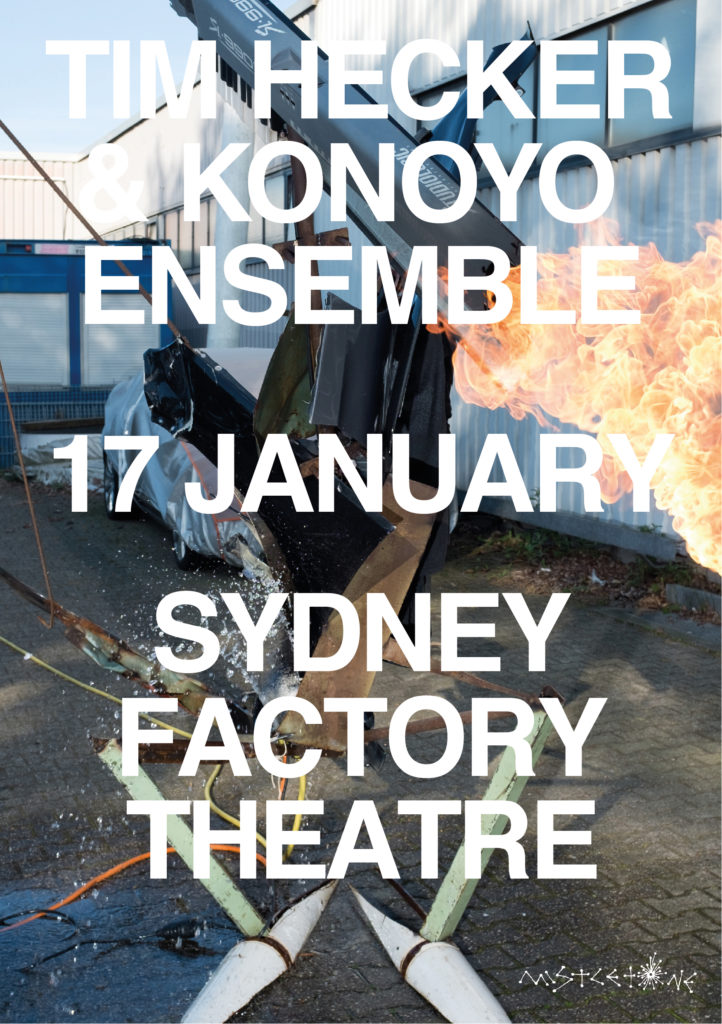Tim Hecker

Mistletone proudly presents a Sydney headline show by TIM HECKER & THE KONOYO ENSEMBLE, playing The Factory Theatre on Friday, January 17. Tickets on sale now.
| Canadian composer Tim Hecker comes to Sydney’s Factory Theatre to present his ninth and tenth official full-length albums, Konoyo (‘the world over here’) and Anoyo (‘the world over there’). Largely recorded during several trips to Japan in collaboration with members of the Tokyo Gakuso ensemble, the albums features Hecker’s signature manipulation of source material — keening strings are stretched into surreal, pixelated mirages; woodwinds warble and dissipate as fractal whispers of spatial haze; sparse gestures of percussion are chopped, isolated, and eroded, like disembodied signals from the afterlife. Performed live with a three piece ensemble of Japanese classical gagaku musicians, this show is a powerful ceremony, suffused with profound ritual. |
from SPIN magazine;
Two winters ago, Tim Hecker traveled to Japan with fellow composer Ben Frostto record what would become Konoyo, his ninth album. A far cry from the heady fog of 2016’s Love Streams, Konoyo plays with a lighter, more crystalline side of drone, in relatively uncrowded soundscapes. The music is informed by gagaku, a type of Japanese classical music relying heavily on the use of ancient instruments; the rigorous formalism of the style is undone over the album’s 59 minutes, thanks in large part to Hecker’s penchant for electronic manipulation. It’s a wholly anomalous take on gagaku, and on Hecker’s own sound, with instrumentation that constantly clashes and interlocks with itself in new and interesting ways.
In an interview with The Japan Times last September, Hecker hinted at the idea of doing a second record—less a companion piece than a new, “naturalist” approach to the material from the Konoyo recording sessions. Anoyo, released earlier this month, is just that. Doing away with much of the inscrutable electronics that characterized Konoyo, Anoyo keeps moments from the original recording sessions largely intact. When I spoke to him about the album last month, he told me about the cold November days spent on the floor of a temple on the outskirts of Tokyo, recording with Tokyo Gakuso ensemble and listening to the birds outside the sliding wooden doors. There’s an existential chill running throughout Anoyo that calcifies in the shivering strings of the opener,“That world.” Towards the middle of the track, individual instruments meld into something approximating the Arctic mist of Ravedeath, 1972 before eventually detangling, and reverting to a more natural state.
In his approach to the new work, Hecker detailed the specific engineering challenges inherent in musical translation, involving different tunings in Eastern and Western music. Bringing different tunings together without adjustment, he says, “just sounds like the worst dog screeching, and not in a good way.” He also discussed the Cube Earth aesthetic of Anoyo’s album art and its relationship to the sound, along with the relative emotional index of his new music. With Anoyo, Hecker pulls back on digital manipulation in favor of something starker, and often more momentous; with all the majesty of a freezing Japanese November, Anoyo feels like a bold new statement from an artist who, 15 years into his career, remains dead set on evolution.
